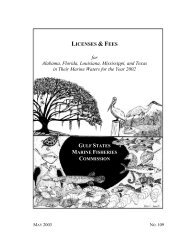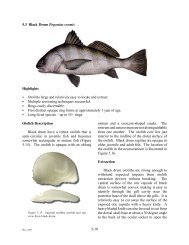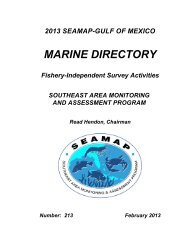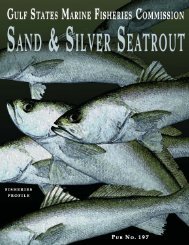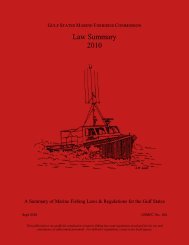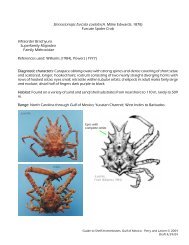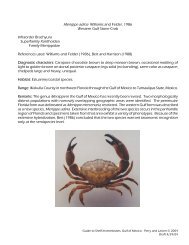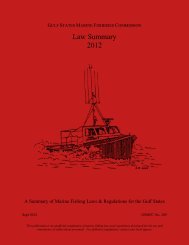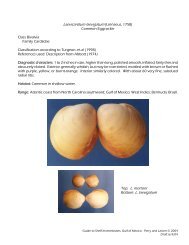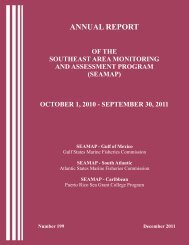Guidelines for Marine Artificial Reef Materials, Second Edition
Guidelines for Marine Artificial Reef Materials, Second Edition
Guidelines for Marine Artificial Reef Materials, Second Edition
You also want an ePaper? Increase the reach of your titles
YUMPU automatically turns print PDFs into web optimized ePapers that Google loves.
the plan should provide a clear estimate of any anticipated funding shortfalls that would have<br />
to be absorbed by states and/or their stakeholders. The federal government should also<br />
prepare an Environmental Impact Statement (EIS) developed in accordance with the<br />
National Environmental Policy Act (NEPA). The alternative that the federal government<br />
provide grant funding to states to deal with MARAD and navy combatants when such<br />
vessels released “as is where is” without any accompanying technical expertise and<br />
assistance is not a preferred alternative.<br />
• Recommend that as part of a coordinated national ship sinking plan, that the EPA, in<br />
conjunction with the USCG and other agencies, develop a consistent and detailed artificial<br />
reef vessel cleaning, preparation and inspection protocol. The Commissions should continue<br />
to press <strong>for</strong> a comprehensive set of vessel cleaning and preparation standards that would<br />
apply uni<strong>for</strong>mly to both federally donated military vessels and civilian vessels procured from<br />
the private sector.<br />
• Recommend that the EPA provide a unified agency policy that addresses the issue of a<br />
vessel sunk as an artificial reef as a “disposal” project versus a “continued use” project.<br />
• Recommend that the EPA clarify issues related to environmental liability and damage, under<br />
the Resource Conservation Recovery Act (RCRA) and Comprehensive Environmental<br />
Response, Conservation, and Liability Act (CERCLA). For instance, is the MARAD or the<br />
Navy, as originators of a material (ship) and any associated hazardous waste, responsible <strong>for</strong><br />
that material or is environmental liability and responsibility transferred by title to the<br />
artificial reef permit holder<br />
• If a federal large ship artificial reef program is developed, recommend that serious<br />
consideration be given to placing some of these vessels as enhanced habitat in established<br />
<strong>Marine</strong> Protected Areas (MPAs) in both the Gulf of Mexico and Atlantic Ocean, with<br />
particular emphasis on supporting potential reef fish spawning aggregations and providing<br />
deep-water outer shelf habitat enhancement at depth of 200-500 feet to such species as<br />
snowy grouper, Warsaw grouper, speckled hind, gag, red snapper, amberjack, and other fully<br />
or over exploited reef fish species. The artificial reef subcommittees of the interstate<br />
fisheries commissions could coordinate with the NMFS and the Gulf and South Atlantic<br />
Fisheries Management Councils to identify either existing MPAs or create new artificial reef<br />
zones <strong>for</strong> these ships with Special Management Zone (SMZ) designations that would<br />
accommodate complete or partial restriction of fishing gear. The authority to create new<br />
SMZs or other MPAs rests with the Regional Fishery Management Councils and NMFS.<br />
Any new SMZs or MPAs <strong>for</strong> such a project should be in an area that has very limited or<br />
absent hard bottom habitat resources and is otherwise not utilized. This will prevent any<br />
possible user conflict and should be supported by all.<br />
• Recommend that if a national large military ship reefing program were established that<br />
involved coordination through the interstate fisheries commissions, then any new<br />
independent ship-by-ship individual applications to MARAD by state agencies terminate.<br />
-41-



